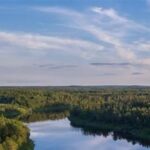When Premier Danielle Smith launched her Alberta Next tour this February, her office billed it as a series of townhalls to gather input from Albertans about the province’s future. Three months and over a dozen events later, critics argue the taxpayer-funded tour increasingly resembles a partisan campaign roadshow rather than genuine public consultation.
I attended the Edmonton leg of the tour last week, where the crowd of roughly 400 was noticeably filled with United Conservative Party supporters. Outside, a small but vocal group of protesters waved signs highlighting concerns about healthcare cuts and environmental policies.
“This isn’t about hearing from all Albertans,” said Sarah Matthews, a local teacher who joined the protest. “It’s a pre-election rally disguised as government outreach.”
The Premier’s Office has spent approximately $850,000 on the tour to date, according to figures obtained through Freedom of Information requests filed by opposition researchers. These costs cover venue rentals, security, technical equipment, and promotional materials featuring Smith’s image prominently.
NDP Opposition Leader Rachel Notley has called the tour “a misuse of public funds” during question period last month. “Albertans deserve better than to see their tax dollars funding what amounts to early campaign events,” Notley stated, pointing to the tour’s carefully controlled format.
At the Edmonton event, attendees submitted questions in advance through a government website, with no opportunity for spontaneous queries from the floor. The Premier took roughly 15 pre-selected questions during a 90-minute session, with nearly half focusing on federal-provincial conflicts—a cornerstone of UCP messaging.
When Cam Wilson, a small business owner from St. Albert, asked about rising commercial rents, Smith quickly pivoted to criticizing federal regulations before offering specific provincial solutions. This pattern repeated throughout the evening.
“I came hoping to hear concrete plans for economic diversification,” Wilson told me afterward. “Instead, I got a stump speech about Ottawa’s failures.”
The tour’s timing has raised eyebrows among political observers. With a provincial election mandated for May 2023, these government-funded community events come just months before the campaign officially begins.
Political scientist Dr. Jared Wesley from the University of Alberta notes the blurring lines between government outreach and partisan activities. “There’s a long tradition of governments using public resources for what they call ‘listening tours’ that conveniently align with pre-election periods,” Wesley explained. “The Alberta Next tour pushes those boundaries further than most.”
Government spokesperson Rebecca Polak defended the tour in an email statement, writing that “Premier Smith is committed to hearing directly from Albertans about their priorities. These sessions provide valuable input that informs government policy development.”
However, tracking how citizen input translates to actual policy has proven difficult. The government has not published comprehensive summaries of feedback received, nor explained how it will be incorporated into future legislation or programs.
This stands in contrast to previous public consultation initiatives like the Fair Deal Panel under former premier Jason Kenney, which produced a detailed public report with specific recommendations.
Finance Minister Travis Toews, when questioned about the tour’s expense during a press conference on provincial spending, suggested the investment would “pay dividends in better policy outcomes.” When pressed for examples, Toews mentioned “dozens of practical ideas” but provided no specifics.
The events themselves feature production values more common to campaign rallies than government forums. Professional lighting, branded backdrops, and slick video presentations precede the Premier’s remarks. Attendees receive glossy handouts highlighting government achievements alongside survey forms asking about voting intentions—an unusual addition for government consultation.
According to Elections Alberta guidelines, government resources cannot be used for partisan campaign purposes. The fine line between legitimate public engagement and pre-election positioning creates what political communications expert Tom Flanagan calls “an accountability gray zone.”
“Smart governments find ways to use incumbency advantages without technically breaking elections laws,” Flanagan told me by phone. “This tour appears carefully designed to thread that needle.”
In smaller communities like Bonnyville, where the tour stopped in March, the feedback has been more positive. Local chamber of commerce president Devon Ritter appreciated the Premier’s visit. “It’s rare we get this level of attention from Edmonton,” he said. “Whether it’s politically motivated or not, at least we had our chance to speak directly to decision-makers.”
As the tour continues with planned stops in Lethbridge, Grande Prairie and Medicine Hat before summer, the debate over its purpose intensifies. Public interest advocacy group Democracy Watch has called for the Auditor General to review the tour’s expenses and practices.
For many Albertans caught between the partisan interpretations, the more fundamental question remains whether their input will matter. As retired oil worker James Petersen put it while leaving the Edmonton event, “I’ve lived through enough governments to know when I’m being listened to and when I’m being talked at. This felt more like the latter.”
Meanwhile, as election season approaches, the line between governing and campaigning continues to blur—leaving taxpayers to foot the bill for what increasingly resembles a political campaign with a government letterhead.






